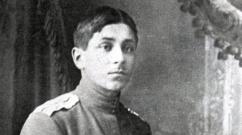Children of Arina Rodionovna. Arina Rodionovna’s bad habits and other facts about Pushkin’s nanny that were not included in textbooks
Arina was her home name, but her real name was Irina or Irinya.
She was born on April 10 (21), 1758, half a mile from the village of Suyda - in the village of Lampovo, Koporsky district, St. Petersburg province. Her mother, Lukerya Kirillova, and father, Rodion Yakovlev (1728-1768), were serfs and had seven children.
As a child, she was listed as a serf of the second lieutenant of the Semenovsky Life Guards regiment, Count Fyodor Alekseevich Apraksin. In 1759, Suida and the surrounding villages with people were bought from Apraksin by Abram Petrovich Hannibal, the great-grandfather of Alexander Sergeevich Pushkin. In 1781, Arina married the peasant Fyodor Matveev (1756-1801), and she was allowed to move to her husband in the village of Kobrino, Sofia district (not far from Gatchina). After marriage, she became a serf of the poet's grandfather, Osip Abramovich Hannibal. She was first the nanny of Nadezhda Osipovna, the mother of Alexander Sergeevich, and then became the nanny of her children: Olga, then Alexander and Lev.
In 1792, she was taken by Pushkin's grandmother Maria Alekseevna Gannibal as a nanny for her nephew Alexei, the son of Mikhail's brother. In 1795, Maria Alekseevna gave Arina Rodionovna a separate hut in Kobrino for her impeccable service. After the birth of Olga in 1797, Arina Rodionovna was taken into the Pushkin family, where she served as a nanny along with her relative or namesake Ulyana Yakovleva.
In 1807, the Hannibal family, together with the peasants, sold land in the St. Petersburg province and moved to the Opochetsky district of the Pskov province.
Arina Rodionovna was “attached” to the owners, and not to the land, so she was “excluded from sale,” and moved with the owners to the Pskov province. In 1824-1826, during the poet’s exile, she lived in Mikhailovskoye. Not only Pushkin, but also Yazykov dedicated his poems to this serf peasant woman, an old woman. Pushkin's friends sent greetings to her in letters to the poet.
After the death of Maria Alekseevna in 1818, she lived with the Pushkins in St. Petersburg, moving with them for the summer to the Mikhailovskoye estate in the Opochetsky district of the Pskov province. In 1824-1826, Arina Rodionovna actually shared Pushkin’s exile in Mikhailovskoye. At that time, Pushkin became especially close to his nanny, listened to her fairy tales, and recorded folk songs from her words. According to the poet, Arina Rodionovna was “the original of Nanny Tatyana” from “Eugene Onegin,” Dubrovsky’s nanny. It is generally accepted that Arina is also the prototype of Ksenia’s mother in “Boris Godunov”, the princess’s mother (“Rusalka”), female images novel "Arap of Peter the Great".
The great poet, using folklore in his work, owed much of this to his nanny. Perhaps that is why Alexander Pushkin said: “If the coming generation will honor my name, this poor old woman should not be forgotten.”
It was Arina Rodionovna who told Pushkin about the hut on chicken legs, about the dead princess and the seven heroes.
Almost until 1811, before he entered the Lyceum, A. Pushkin lived under the same roof with Arina Rodionovna. It is no coincidence that the poet, addressing Arina Rodionovna, often calls her not only “nanny,” but also “mummy.” The relationship between the poet and the nanny in the village of Mikhailovskoye, during the years of Pushkin’s exile, became especially warm. In Mikhailovskoye, Arina Rodionovna not only guarded the estate, but also managed all the master’s affairs. This is what the poet wrote to his brother Lev in those years: “I write notes before lunch, have lunch late... In the evening I listen to fairy tales.” He wrote down fairy tales, of which the nanny knew a great many, songs, and with interest “collected” sayings, proverbs, and folk expressions told to her.
The last years of her life she lived in St. Petersburg in the family of the poet's sister, Olga Pushkina (by her husband - Pavlishcheva). Arina Rodionovna died at the age of 70, in 1828. This is the simple life story of A. Pushkin’s nanny, whom he called “the confidante of magical antiquity,” “a friend of my youth,” “a good friend,” etc. The poet himself in his works created a romantic image of his beloved nanny. This idea was continued by his contemporaries. We practically do not know what Arina Rodionovna was like in real life. Even about her appearance, only a few lines are said: “A venerable old lady - plump-faced, gray-haired, who loved her pet...”
Sources: , .
Probably, each of us associates with the name of A.S. Pushkin the personality of his beloved nanny, Arina Rodionovna, to whom he dedicated several of his poems. She told him fairy tales, which he later used as the basis for his creations. And it is possible that if it were not for her, the world would not know the wonderful fairy tales written by the world famous poet. Now we will tell you in detail who she is nanny Pushkin Arina Rodionovna, biography brief content.
Everyone knows that Alexander Sergeevich’s nanny’s name was Arina Rodionovna. But few people know that in reality nanny Pushkin had another Name surname. In fact, she was originally named Irina, which is the name listed in church documents about her birth and death. They called her Arina only in the home circle and when she came to serve in the Pushkin house. By the way, a very interesting fact is that Alexander Sergeevich himself never mentioned the name of his nanny in his poems.
But if everything is clear with the name of Pushkin’s nanny, then the question of Arina Rodionovna’s surname is even more controversial. In fact, Pushkin’s nanny simply did not have a surname. Since she was a representative of the peasant class and she didn’t really need her. She was often given the surname Rodionova - on behalf of her father, but the Pushkins called her Rodionovna.
Then historians gave her the surname Yakovleva, since this was the surname that her father had. But Pushkin scholars are still arguing about this. Since this has not been proven by anything and none of her contemporaries called her by this name. And after marriage, it is customary to consider her Matveeva.

Arina Rodionovna was born on April 21, 1758 in the village of Suyda, St. Petersburg province. Her mother’s name was Lukerya Kirillova, and her father’s name was Rodion Yakovlev, and they raised seven children.
Who is she by origin?? Of course she's a peasant. Initially it belonged to Count Apraksin, but then Pushkin’s great-grandfather, Abram Petrovich Hannibal, bought the estate from him. And then Arina Rodionovna became his property. This is how her service to the family of the future poet began.
In 1781 she married Fyodor Matveev. And when she began to live with her husband, she began to serve Osip Abramovich Hannibal. Then she served as a nanny for his daughter, Nadezhda Osipovna.
In 1792, Alexander Sergeevich’s grandmother, Maria Alekseevna Hannibal, took her in to raise her nephew Alexei. For good and faithful service, she was given her own separate hut.
After the birth of Nadezhda Osipovna’s eldest daughter, Olga, she began to raise her. And then she nursed her brothers - Alexander and Lev. 
In 1807, the Hannibals ceded all their lands in the St. Petersburg province and left for the Pskov province. Namely, in Opochsky district.
It was not part of the sold property because it was assigned to the owners. And so she also moved to a new place. By the way, the Pushkin family at one time wanted to give her freedom, but she refused it.
When Maria Alekseevna died, Pushkin’s nanny began to live in St. Petersburg with her owners. And just like them, she went to the Mikhailovskoye estate in the Pskov province for the whole summer.
In the period from 1824 to 1826, she lived in this estate, when Alexander Sergeevich was in exile.
After a short illness, when she was 70 years old, Arina Rodionovna died on July 31, 1828 in St. Petersburg, in the house of Pushkin’s sister Olga.
The farewell to the nanny was modest, in accordance with her social status, and there was no signature on the grave. By the way, Alexander Sergeevich himself did not come to say goodbye to his favorite. And of the members of their family, only the husband of his sister Olga, Nikolai Pavlishchev, was there.
For a long time, historians could not find the place where Arina Rodionovna was buried. And until 1940, everyone thought that her grave was in the Bolsheokhtinsky cemetery. But after checking the records in church books, it became clear that she rests in the Smolensk cemetery in St. Petersburg. And now at the entrance to the cemetery hangs a memorial plaque in honor of the great poet’s nanny.
At school, during literature classes, we were always told what a significant role nanny Pushkin Arina Rodionovna biography brief content had V life Pushkin and his development as a poet. But the relationship between them became truly close only during the period of his exile. And, by the way, it was then that he wrote poems in her honor.
During that period, they often spent time together, and the nanny told him various fairy tales and sang songs. She succeeded simply wonderfully - here for What her loved Pushkin. Many people think that this is what served as the basis for those fairy tales that Pushkin himself wrote.
Pushkin composed his fairy tales five years after the end of his exile. And probably, if not for his nanny, we would not have known these wonderful stories about the goldfish, about Tsar Saltan and others that all children know.

At present, we will no longer be able to objectively assess Arina Rodionovna’s contribution to the development of Alexander Sergeevich’s personality as a poet and writer. But the fact is undeniable that the great poet loved her very much, and the time spent with her brought him only positive emotions.
ABOUT appearance There are no descriptions of Arina Rodionovna. Below you can see a portrait of one artist, it is he who is considered the portrait of Pushkin’s nanny. But if you read the lines written by Alexander Sergeevich’s sister, Olga, about the appearance of their nanny, then they are unlikely to correspond to the image in the picture. She wrote that Arina Rodionovna had a full face and completely gray hair. There were no further references to her appearance.

A drawing by Alexander Sergeevich was also found, which possibly depicts his nanny at a young and old age.
Alexander Sergeevich treated his nanny very kindly and lovingly. He even used her image in his poem Eugene Onegin - the personality of his nanny became the prototype of Tatiana's nanny. He wrote about her that she was his only friend and only with her was he not bored. Pushkin always thought about his nanny with great warmth and dedicated poems to her. Below you can read Pushkin’s most famous poem, dedicated to his nanny.

Another thing that tells us about Arina Rodionovna’s appearance is the well-known bas-relief, which was made of bone. Where it came from and who its author is is still unknown. They first learned about its presence only when it ended up with Maxim Gorky. 
Now you can see the bas-relief of Arina Rodionovna with your own eyes in the Central Museum of A.S. Pushkin, which is located in St. Petersburg.
So we told you all the details about the personality of nanny A.S. Pushkin. Do you understand who Pushkin’s nanny Arina Rodionovna was? Biography summary helped put together the show? Leave your opinion or feedback for everyone on the forum.
Arina Rodionovna. Portrait of an unknown artist./Public DomainOn April 21, 1758, a daughter, Irina, was born into the family of the serf Rodion Yakovlev, who was destined to become the nanny of the “sun of Russian poetry.”
Friend of my harsh days,
My decrepit dove!
Alone in the wilderness of pine forests
You've been waiting for me for a long, long time.
You are under the window of my little room
You're grieving like you're on a clock,
And the knitting needles hesitate every minute
In your wrinkled hands...
If the most famous nanny in the West is Mary Poppins, a fictional character, then in the post-Soviet space the main nanny of all times has become a very real person - Alexander Sergeevich Pushkin’s nanny Arina Rodionovna.
Pushkinists are still arguing about her actual influence on the work of the main poet of Russia, but one thing is certain - the image of Arina Rodionovna has become an integral part of Russian culture.
There are also different opinions about the place of birth of Arina Rodionovna. An entry found in the Parish Register of the Church of the Resurrection of Christ in Suida indicates that Pushkin’s nanny was born on April 10 (April 21, new style) 1758 in the village of Voskresensky, into the family of serfs Rodion Yakovlev and Lukerya Kirillova. At birth, the girl was named Irina, or Irinya, but history has preserved the colloquial form of the name that was accepted at that time - Arina.
As for the double name of the village where Arina Rodionovna was born, until 1718 it was called Suida, and the new name was assigned to it after the construction of the Church of the Resurrection of Christ in it.
Arina’s parents were listed as serfs of the second lieutenant of the Semyonovsky Life Guards regiment, Fyodor Alekseevich Apraksin. When the girl was one year old, the village, along with the peasants, was sold to General-in-Chief Abram Petrovich Hannibal, Pushkin’s great-grandfather, the same “amoor of Peter the Great.”
Arina's parents had seven children, they lived poorly. An already difficult life became very difficult after the head of the family, Rodion Yakovlev, died in 1768.
Arina began working on the landowner's estate while still a very young girl, many years before the birth of her famous pupil. She was recommended to the gentlemen by her brother Simeon, who had previously been hired as a coachman.
In addition to working on the estate, Arina was engaged in needlework, which was very common among serf girls of that era. She herself was an excellent needlewoman, which Alexander Pushkin later noted.
By the standards of that time, Arina Rodionovna married quite late, at 23, to the serf Fyodor Matveev. The wedding was prepared hastily - Abram Petrovich Hannibal was very ill by that time, and after his death the property was supposed to be divided between his sons, as a result of which the bride and groom could be separated forever.
After marriage, Arina Rodionovna moved in with her husband and after the death of Abram Hannibal, she became the serf of Osip Abramovich Hannibal, Pushkin’s grandfather.
In her marriage to Fyodor Matveev, Arina Rodionovna had four children, but family life didn't work out. The husband drank and eventually died from drunkenness in 1801. The family didn’t even have cattle, so the main breadwinner for her husband and children was Arina Rodionovna, who in 1792 was taken by Pushkin’s grandmother Maria Alekseevna Hannibal as a nanny for her nephew Alexei, the son of his brother Mikhail.
Maria Alekseevna was very pleased with the nanny - so much so that three years later Arina Rodionovna was given a separate hut.
Arina Rodionovna was the nanny of all three Pushkin children - Olga, Alexander and Lev. Pushkin scholars, who call the nanny by her father’s name “Arina Yakovleva,” note that at the same time another nanny, Ulyana Yakovleva, who was not a relative of Arina Rodionovna, also served in the Pushkin house.
An interesting point: according to researchers, Arina Rodionovna performed the direct, classic duties of a nanny in relation to Olga and Lev, while the care of little Sasha was entrusted to Ulyana Yakovleva.
However, Pushkin always called Ulyana “nanny” and did not have particularly warm feelings for her, unlike Arina Rodionovna. The future poet was fascinated by the fairy tales and lullabies of Arina Rodionovna, which she told and sang much better than her colleague.
The Hannibal family sold the lands that belonged to them several times, but Arina Rodionovna by that time was assigned not to the villages, but to the masters, so these transactions did not affect her fate in any way.
Arina Rodionovna lived with Sasha Pushkin under the same roof almost until the moment he entered the Lyceum in 1811. She greatly influenced the boy’s creative nature—in his letters, Pushkin often called her “mummy.”
After her pupils grew up, Arina Rodionovna lived with the gentlemen in the Pskov province. In 1818, Pushkin’s grandmother Maria Hannibal died, and after her death, Arina Rodionovna lived with the Pushkins in St. Petersburg, returning with them in the summer to the Pskov region, to the village of Mikhailovskoye.
Let's have a drink, good friend
My poor youth
Let's drink from grief; where is the mug?
The heart will be happier.
Sing me a song like a tit
She lived quietly across the sea;
Sing me a song like a maiden
I went to get water in the morning.
Pushkin wrote the well-known lines about the nanny and the mug in 1825 in Mikhailovsky, where he was in exile from 1824 to 1826. Arina Rodionovna actually shared the exile with the matured pupil, becoming his closest person and inspiration at that time.
Pushkin rediscovered the fairy tales he heard in childhood, carefully wrote them down, and later they became the basis for his works.
The image of the nanny herself also appeared in the poet’s works - Arina Rodionovna was the prototype of the nanny Tatiana from “Eugene Onegin”, the prototype of Ksenia’s mother from “Boris Godunov” and several female images from “Arap Peter the Great”.
In November 1824, Pushkin wrote to his brother: “Do you know my studies? I write notes before lunch, have lunch late; After dinner I ride horseback, in the evening I listen to fairy tales - and thereby compensate for the shortcomings of my damned upbringing. What a delight these tales are! Each is a poem!
The Russian poet Nikolai Yazykov, who visited Pushkin in Mikhailovsky and personally knew Arina Rodionovna, called her a “cheerful drinking companion.” So the lines about the circle in Pushkin’s poem appeared for a reason. However, it is unlikely that Arina Rodionovna abused alcohol, otherwise there would have been no question of many years of impeccable service as a nanny.
"My dear friend
Alexander Sergeevich, I received your letter and the money you sent me. For all your mercies, I am grateful to you with all my heart - you are constantly in my heart and on my mind, and only when I fall asleep do I forget you and your mercies to me... Your promise to visit us in the summer makes me very happy. Come, my angel, to us in Mikhailovskoye, I’ll put all the horses on the road... I will wait for you and pray to God to let us meet... Farewell, my father, Alexander Sergeevich. For your health, I took out the bread and served a prayer service, live well, my friend, you will fall in love yourself. I, thank God, am healthy, kiss your hands and remain your much-loving nanny, Arina Rodionovna.”
Pushkin’s last meeting with Arina Rodionovna took place in the village of Mikhailovskoye on September 14, 1827. The nanny was already 69 years old, which at that time was the age of extreme old age.
In January 1828, Pushkin's elder sister Olga married against the will of her parents. With her husband Nikolai Pavlishchev they settled in St. Petersburg. In March, Olga's parents reluctantly allocated her several serfs to run the household. Among those whom Olga took in was her old nanny.
For Arina Rodionovna, this March trip to St. Petersburg, still on the winter route, turned out to be too much of a burden. She died on July 31 (August 12, new style) 1828 in St. Petersburg, in the house of the Pavlishchevs.
Pushkin was not present at the nanny’s funeral, and his sister Olga did not participate in it. Olga's husband, Nikolai Pavlishchev, buried the nanny.
Arina Rodionovna was born and died a serf, and no attention was paid to the burials of people of such low status. When in 1830, Pushkin, who had come to his senses, tried to find the grave of his “mother” with his friends, he failed. Only a century later, researchers were able to establish that Arina Rodionovna was buried in the Smolensk cemetery in St. Petersburg, but her grave was lost forever.
In 1977, a memorial plaque appeared at the Smolensk cemetery in memory of Arina Rodionovna. The text on it reads:
“Arina Rodionovna is buried in this cemetery
nanny of A. S. Pushkin
1758-1828
“Friend of my harsh days,
My decrepit dove!”
The main nanny of Russian literature turns 260 years old.
Fate made sure that just such a person appeared on Alexander Sergeevich’s path. Arina Rodionovna gave the poet her love, was for him not only a nanny, but a true friend. The old lady could grumble, be feignedly strict, but Alexander knew about her boundless love for him, says Olga Solodovnikova, head of the department of the A.S. Pushkin Central Library.
Having found herself in the Pushkin house as a nanny for the poet’s older sister Olga and his younger brother Lev, she did not immediately begin to look after little Sasha. He was watched by two other women and uncle Nikita Kozlov, who then escorted the coffin with the poet’s body on its last journey. And yet, only Pushkin called her his nanny; he more than once addressed her or the images inspired by her in his poems.Arina Rodionovna raised all the lordly children in her care in Russian. She skillfully and sincerely told fables, scary stories, fairy tales, knew popular beliefs, sprinkled with proverbs and sayings. Not only children, but also all the house servants loved to listen to her. . “Despite the fact that everyone around us was strictly forbidden to frighten us with witches and brownies, the nannies talked about them among themselves all day long,”- recalled the poet’s sister Olga. Scientists say that the information and knowledge that a child receives before the age of seven shapes his personality.It was during this period that young Sasha first heard about the hut on chicken legs and the fairy tale about the dead princess and the seven heroes.Apparently, in fact, the serf peasant woman had a special gift and conquered children's souls, and her speech was forever etched in their memory. This role of hers is especially important because in the poet’s childhood “his upbringing contained little Russian; he only heard French.”Almost until 1811, before he entered the Lyceum, Pushkin lived under the same roof with Arina Rodionovna.He loved her with a kindred, unchanging love,often calling her not only “nanny”, but also “mummy”.
However, a special closeness between Pushkin and Arina Rodionovna developed already during his two-year exile. In July 1824, the disgraced poet from St. Petersburg was exiled to the village of Mikhailovskoye, Pskov province, under the supervision of local authorities. And here he was greeted with joy by his aged nanny, who still loved her Sasha just as much. In Mikhailovskoye, Arina Rodionovna not only guarded the estate, but also managed all the master’s affairs. In memoirs dedicated to exile, the names of the nanny and the poet are inseparable. In the house, the nanny's and Pushkin's rooms were next to each other. “The entrance to it is directly from the corridor; Opposite his door is the door to the nanny’s room, where there were many embroidery frames.”- recalled I.I. Pushchin. According to Pushkin’s coachman P. Parfenov: “ He is always with her when he is at home. As soon as she gets up in the morning, she runs to see her: “Is she okay, mom?” - he kept calling her mom... And just when the old woman gets sick there, he’s always after her...”.
They whiled away the evenings together.The nanny sat down at the table with her eternal stockings or with a spinning wheel and, with the spindle running briskly in her hands, she told her fairy tales - melodiously, simply,which, according to the poet himself, she did excellently. He often came to her small house, located next to the master’s, giving rise to legends that Pushkin did not even live at his place, but in the “nanny’s house.” In a letter to an acquaintance, Pushkin wrote in December 1824: “...in the evening I listen to my nanny’s fairy tales...; She’s my only friend - and she’s the only one I’m not bored with.”
The entire fabulous Russian world was known to her as briefly as possible, and she conveyed it in an extremely original way.In November 1824, Pushkin wrote to his brother Lev: “ Do you know my classes? I write notes before lunch, have lunch late; After dinner I ride horseback, in the evening I listen to fairy tales - and thereby compensate for the shortcomings of my damned upbringing. What a delight these tales are! Each one is a poem!”. And he wrote down fairy tales, of which the nanny knew a great many, songs, and with interest “collected” the sayings, proverbs, and folk expressions told to her.
For example, let’s compare fragments of one of the nanny’s fairy tales recorded by Pushkin and the prologue of the poem “Ruslan and Lyudmila ": "...here's a miracle: by the sea of the Lukomorye there is an oak tree, and on that oak tree there are golden chains and on those chains a cat walks, he goes up and tells tales, he goes down and sings songs... and here's a miracle: 30 youths come out of the sea exactly like “They are exactly the same in voice, hair, face, and height, but they leave the sea only for one hour... and there is an old man with them...”.
And in Pushkin's poem:
There is a green oak near the Lukomorye;
Golden goal on the oak tree:
Day and night the cat is a scientist
Everything goes round and round in a chain...
The creative individuality of Arina Rodionovna the storyteller was studied by folklorist M.K. Azadovsky. Based on Pushkin’s recording of seven folk tales, the scientist noted that the performer mastered the traditional repertoire, which appears in “excellent preservation, great artistic power and poetic freshness.” She readily used the numbers 30 or 33 and rhymed freely. In a purely fairy-tale tradition, she used names and nicknames, especially often using her favorite epithet: golden.
Thus, Arina Rodionovna’s creative gift, wisdom, patience, hospitality and tender love for her pet earned the constant respect of Pushkin, his friends and admirers of his talent. In the poem by A.S. Pushkin’s “Matchmaker Ivan, how will we drink…” is a portrait of his beloved nanny:
She was a craftswoman!
And where did you get it from?
And where are the jokes reasonable?
Sentences, jokes,
Tales, epics
Orthodox antiquity!
It's such a joy to listen to!
And I wouldn’t drink and I wouldn’t eat,
Everyone would listen and sit.
Who came up with them so well?
Much later, having already become famous, Pushkin would conclude that familiarity with ancient songs, epics, and fairy tales is necessary for a perfect knowledge of the basics of the Russian language.The important role of the nanny's fairy tales in the life and work of Pushkin was noted by the critic and poet Apollo Grigoriev: “Oh, the fairy tales of Arina Rodionovna... you kept such a bright, pure stream in the soul of a young, French-bred nobleman that distant posterity will remember you kind words and blessing..."
Pushkin began to write his fairy tales later; he carried their ideas within himself for a long time; time had to pass for his fairy-tale works to see the light of day.Almost all of Pushkin’s tales were born already in 1830-31, that is, five years after the seclusion in Mikhailovskoye.
Pushkin’s old “mother”, with the light hand of the poet who created a poetic, romantic myth about his nanny, entered Russian literature forever, becoming a “textbook image.” He sang about her in poems from different periods,calling him “confidante of magical antiquity”, “friend of my youth”, “good friend”:
Confidant of magical antiquity,
Friend of playful and sad fictions,
I knew you in the days of my spring,
In the days of initial joys and dreams.
I've been waiting for you; in the evening silence
You were a cheerful old lady,
And she sat above me in the shushun,
With big glasses and a frisky rattle...
The poem “The Confidant of Magical Antiquity” is absolutely unique in that in it the old nanny and the lovely maiden Muse appear as two incarnations of the same person.
According to the poet, Arina Rodionovna was the “original” of Dubrovsky’s nanny, Tatyana’s nanny from Eugene Onegin. It is generally accepted that she is also the prototype of Ksenia’s mother in “Boris Godunov”, the female characters in the novel “The Blackamoor of Peter the Great”, and the princess’s mother (“Rusalka”).
For example, in his poem “Eugene Onegin,” Pushkin describes a conversation between the main character of the work, Tatyana Larina, and her nanny (as Pushkin himself said, “the original nanny Tatyana”); it is quite likely that it conveys the sentiments of this fact of life of his beloved nanny - such was the typical lot of a Russian peasant woman in those years:
Tell me, nanny,
About your old years:
Were you in love then?
And, that's it, Tanya! These summers
We haven't heard about love;
Otherwise I would have driven you away from the world
My deceased mother-in-law. —
“How did you get married, nanny?”
So, apparently, God commanded.
My Vanya was younger than me, my light...
And I was thirteen years old.
To your beloved nanny, dear and to a loved one, a simple peasant woman, the poet dedicated his poem, which is called “Nanny”. The poem was written in October 1826 in Moscow, where Pushkin was unexpectedly summoned by the Tsar, which greatly alarmed Arina Rodionovna.Anton Delvig in a letter asks his lyceum friend: “ My soul, the situation of your nanny frightens me. How did she cope with the completely unexpected separation from you?” She didn’t bear it very cheerfully, servant Pyotr Parfenov recalled: “Arina Rodionovna has stretched herself and is crying bitterly”. At the beginning of November 1826, Pushkin was again in “his hut,” as he liked to call Mikhailovskoye. From there he wrote to Vyazemsky: “You know that I’m not feigning sensitivity, but the meeting of my servant... and my nanny - by God, tickles the heart more pleasantly than words... My nanny is hilarious. Imagine that at the age of seventy she learned a new prayer about the tenderness of the Lord’s heart and taming the spirit of his ferocity, a prayer probably composed under Tsar Ivan.” It is not difficult to guess whose heart Arina Rodionovna wanted to “touch”, whose ferocity “to tame.” She begged the autocrat for mercy to the beloved of her soul, Alexander Sergeevich. From the memoirs of Alexandra Osipovna Smirnova, the Empress’s maid of honor: “ The Emperor spoke with Pushkin about his poor Arina Rodionovna (the poet felt very sorry for her). The Emperor spoke about old Russian servants and about poems where Pushkin mentions his grandmother and old nanny.”
The nanny, the poet’s first and most faithful friend, is remembered by his contemporaries, close friends, for whom Arina Rodionovna also became a family member. Prince Peter Andreevich Vyazemsky writes: “Rodionovna, my bow to the waist.” Ivan Ivanovich Pushchin, returning from Mikhailovsky, asks Pushkin in a letter: "Bow to the nanny."
“Svet Rodionovna, will I forget you?” - wrote the poet Nikolai Mikhailovich Yazykov, who visited Pushkin in the spring of 1826. He was delighted with Arina Rodionovna. “I'm crazy about your nanny! What motherly care she has for you. Her spiritual beauty, wonderful folk speech, and captivating stories about antiquity and past life are amazing!” Nikolai Mikhailovich, subsequently, dedicated the poem “How sweet is your holy hospitality…” to her.
And according to A.P. Kern, Pushkin " He truly loved no one except his nanny...”
The last time the poet met his beloved nanny in the village of Mikhailovskoye was in September 1827. By that time, Arina Rodionovna was already 69 years old. By January 1828, Pushkin's older sister Olga decided to get married. The parents were against their daughter’s marriage to Nikolai Pavlishchev. The couple settled in St. Petersburg, and the parents, stepping over themselves, had to provide them with serfs to run the household. Among them was Arina Rodionovna.
She had to travel to the capital in March. The still winter-cold road took a lot of energy from her - the nanny began to get sick. She died in the Pavlishchevs' house on August 12, 1828.
Arina Rodionovna was buried at the Smolensk cemetery in St. Petersburg. Two years later, Alexander Pushkin tried to find her grave, but could not - it was lost forever. Only in 1977 did a plaque appear at the Smolensk cemetery in memory of the poet’s nanny.
In 1880, when more than 40 years had passed since Pushkin’s death, the writer I.S. At the opening of the monument to the poet in Moscow, Aksakov will give a speech about a simple peasant woman, Arina Rodionovna: “From adolescence to the grave, this brilliant, renowned poet was not ashamed to publicly, in wonderful verses, profess his tender affection not for his mother, but for his nanny... So who is the first inspirer, the first muse of the great artist - this is the nanny, this is a simple village woman! May she, this nanny, and on behalf of Russian society, have eternal grateful memory!”
Pushkin managed to create a kind, poetic image of his beloved nanny, but, surprisingly, practically nothing is known about Arina Rodionovna’s appearance.
The portrait of a nanny by an unknown artist is widely known. It can even be found in school textbooks.
But does it match the real appearance of the nanny? At the very least, it contradicts the only description of Arina Rodionovna that has reached us, made byPraskovya Alexandrovna Osipova: “The old lady is extremely respectable - plump-faced, all gray-haired, passionately loving her pet...” There are no more words left in history about the nanny’s appearance.
There is also a famous high relief of Arina Rodionovna, carved from bone. Its history is shrouded in mystery - it first became known in 1911, when it fell into the hands of Maxim Gorky, who lived at that time in Italy on the island of Capri. Where exactly the high relief came from is never clear. Today this portrait is kept in the Central Museum of A.S. Pushkin in St. Petersburg.

In addition, in the margins of Alexander Sergeevich’s workbooks, Pushkin scholars discovered two profile portraits. First, the head of an old woman in a military uniform is drawn, and next to her is a half-length portrait of a girl in a sundress, with a braid and a bandage on her head. Upon closer examination, it turned out that the faces of the old woman and the girl are strikingly similar and are a portrait of the same person in youth and old age. In the first portrait she is drawn, probably, as the poet last saw her, on her deathbed - before us is the face of an old woman with already frozen features, with drooping eyelids. Next to it, Pushkin painted a portrait of young Arina Rodionovna, it is more clear: the expression on the young woman’s face is lively and perky. Drawing Arina Rodionovna young, the poet probably recalled his nanny’s stories about her youth.

In various sources you can find many reproductions of paintings depicting A.S. Pushkin and his faithful nanny. But they are all just a figment of the artists’ imagination, reflecting rather inner essence this amazing woman, but not in appearance similar to the original.
In 1875, at the 4th exhibition of the Association of Itinerants, Nikolai Ge exhibited his new painting “Alexander Sergeevich Pushkin in the village of Mikhailovskoye.”

The painting depicts a meeting of lyceum friends in January 1825 in the village of Mikhailovskoye, when early in the morning Pushkin came to visit him for just one day best friend Ivan Pushchin, who brought A.S. Griboyedov’s then-banned comedy “Woe from Wit,” and Pushkin wanted to read it aloud. Pushchin settled down in an armchair, and Pushkin, with his irrepressible temperament, sat and read while standing. The nanny sits behind him with her knitting and also listens. This is the moment we see on the artist’s canvas.
The next morning Pushchin leaves, and Pushkin writes to him in Chita, where Pushchin was in exile after the December uprising on Senate Square:
My first friend! My friend is priceless!
And I blessed fate
When my yard is secluded,
Covered in sad snow,
Your bell rang.
A true ode to friendship! After the exhibition, the painting was acquired by N.A. Nekrasov.
An example of genre painting is the painting by P.I. Geller (1862 - 1933) “Pushkin and the Nanny,” written by him for the 100th anniversary of the Poet’s birth.

The painting depicts a room filled with books, in which Pushkin and his nanny are comfortably seated. The nanny has knitting on her lap, she is telling something to her beloved Alexander Sergeevich, and he listens carefully and writes it down.
Ilya Repin’s student Nikolai Ivanovich Shestopalov created canvases dedicated to A. S. Pushkin, amazing in the organic nature of their chosen themes. In the fateful but also anniversary year of 1937, Nikolai Shestopalov became an artist at the Pushkin Museum-Reserve. And during these years, on his paintings and wonderful watercolors appear landscapes of Mikhailovsky and Trigorsky, manor interiors, views of the Svyatogorsky and Pechora monasteries, ancient Russian architecture of white-stone Pskov. After all, this, whatever one may say, is the whole life of a Russian landowner. This is a manor house, a wonderful nanny with Russian fairy tales, the eternal annual cycle of peasant life, visits to monasteries and church services.
Paramonov Alexander Nikitich (1874-1949), graphic artist, monumentalist. He studied at Baron Stieglitz's Central Theater Arts Center in the department of etching and decorative painting under V.V. Mate, G.M. Manizer, A.P. Savinsky. In 1936, on the eve of the celebration of the great poet’s centenary, he painted the painting “Pushkin and the Nanny.” Paper, etching, drypoint.At the bottom of the sheet is an excerpt from a poem by N. Yazykov and a view of a house in Mikhailovskoye.The plot is traditional: the nanny, while knitting, tells Pushkin her “legends of deep antiquity,” and the poet, sitting in a chair, listens to her and writes down what he heard in a notebook.

In 1938, the young artist Yuri Neprintsev, graduating from the institute, presented the painting “Pushkin in the village of Mikhailovskoye” as his graduation work. Throughout his entire life, the “Pushkin” theme of Yu.M. Neprintsev considered one of the most important in his work.

Among the famous Russian artists and graphic artists is the no less famous book illustrator Yuri Valentinovich Ivanov. Many people know his beautiful painting “Pushkin and Arina Rodionovna”.

The poet is depicted at the same table with his faithful and reliable friend, the nanny. We see part of the room: the wooden walls are hung with icons, on the table in the corner of the room there is a lonely candle in a candlestick and a box with nanny’s knitting supplies. Pushkin’s nanny sits at the table with a ball of knitting thread. Pushkin himself sits on the opposite side of the table. His head is supported by his hand. The look is kind of thoughtful. The poet is dressed, as always, in a formal suit. The head is covered with curls of hair with long sideburns. On the floor, near the nanny’s feet, the cat is curled up in a ball and sleeping sweetly.
St. Petersburg artist Igor Shaimardanov, the author of a series of paintings about Pushkin, provided works dedicated to the poet’s nanny. According to the artist’s plan, in the gallery of images of Arina Rodionovna, the viewer is presented with portraits stylized as ancient paintings early XIX century. Shaimardanov also repeatedly turned to Pushkin’s theme in his work, creating several series of comic paintings about the poet’s life, which, according to the author himself, depict “invented, fictitious and almost true stories.”
MOSCOW, April 21 - RIA Novosti, Anna Kocharova. On this day 260 years ago, according to the new style (April 10, according to the old style), Arina Rodionovna Yakovleva, Pushkin’s nanny, was born.
The life of this serf peasant woman was closely connected with the famous family. Read about the plots of which works she suggested to Pushkin and why they remained in the history of Russian literature in the RIA Novosti material.
It seems that in this woman’s life there was no one except the great Russian poet. Since childhood, from the school curriculum, we know poems addressed to her. Since childhood, we have read about how she carefully looked after her charge.
Small in stature, the same as Pushkin. Lively, sharp-tongued, full-faced - this is what is known about what Arina (or, according to some sources, Irina) Rodionovna looked like. The poet's contemporaries, describing her, noted the main thing: she devotedly loved her Alexander Sergeevich.
One portrait of Arina Rodionovna by an unknown master has survived, says Natalya Klyushina, head of the museum “A.S. Pushkin’s Nanny’s House.” But it seems that we all know what she looked like since childhood. After all, for readers she has long become such a popular nanny and grandmother, says artist from St. Petersburg Igor Shaimardanov, author of a series of paintings on Pushkin themes. His works, as well as other artifacts related to the nanny’s life, are presented at the exhibition “Arina R’s DR” in the St. Petersburg exhibition hall “Smolny”.
© Provided by State Budgetary Institution of Leningrad Region "Museum Agency"
© Provided by State Budgetary Institution of Leningrad Region "Museum Agency"
Much is known today about the biography of Pushkin’s nanny; her life has long become a sphere of scientific interest for Pushkin scholars. “As a girl, at about the age of ten, she lost her father,” says Natalya Klyushina. “From an early age she lived in poverty and labor, she knew how to spin, weave, embroider, and weave lace.”
She got married quite young and gave birth to four children - sons Yegor and Stefan, daughters Nadezhda and Maria. Researchers write that she could attract the attention of gentlemen to herself with her sharp conversation and perkiness. But her husband, Fyodor Matveev, was respected by his fellow villagers. Rare christenings and marriages took place without an invitation and his participation as a guarantor.
The Pushkins, apparently, treated their caring nanny in a special way. She nursed an entire generation of this family.
“They offered her freedom, but she refused,” says Natalya Klyushina. “Arina Rodionovna saw that Nadezhda Osipovna (mother of Alexander Sergeevich. - Ed. note. ) going to become a mother, and considered it necessary to stay in this family. In addition, the peasants assigned to the court, unlike those who worked on the land, occupied a special position in the master’s families: this included clothing, food, and respect.”
The nanny was given a separate house in Kobrino. But later, having followed her family to Moscow, she agreed that her children could follow her. Two daughters and the youngest son left. The eldest remained in Kobrino. For many years, until the mid-twentieth century, the descendants of Arina Rodionovna lived there.
“This lively old lady knew a lot of fairy tales, ditties, sayings, sayings,” continues Natalya Klyushina. “She was illiterate and couldn’t read. But she was distinguished by folk wisdom, apt expressions, sharp words. Pushkin wrote down seven fairy tale plots from the words of Arina Rodionovna. Three have come down to us in poetic adaptation: “The Tale of Tsar Saltan”, “The Tale of the Priest and his Worker Balda” and “The Tale of the Dead Princess”.
“Pushkin loved his nanny very much, dedicated many poems to her, “Nanny,” “Winter Evening,” “Town,” recalls the head of the museum “A.S. Pushkin’s Nanny House.” “And paradoxically, he did not devote a single poem to mother, nor father. Arina Rodionovna knew how to listen and advise. She gave all her love, warmth and kindness to Pushkin.”













